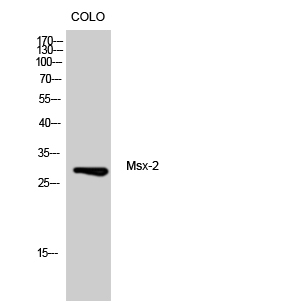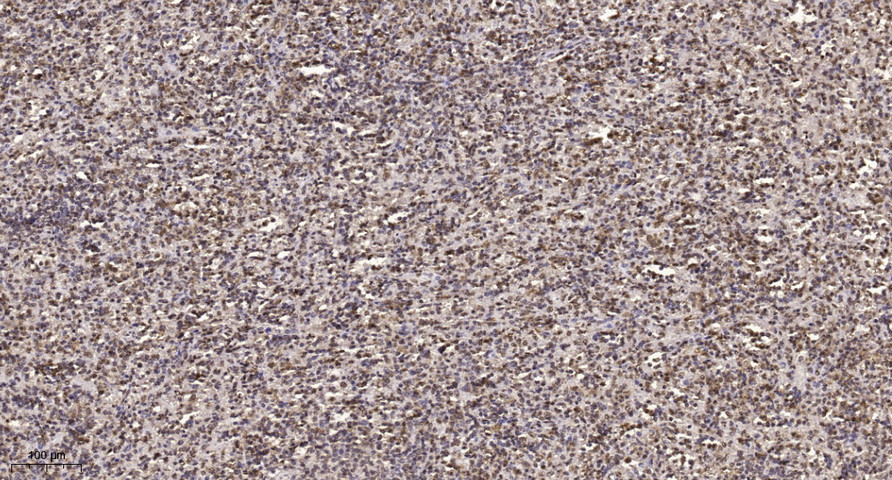Msx-2 Polyclonal Antibody
- Catalog No.:YT2905
- Applications:WB;IHC;IF;ELISA
- Reactivity:Human;Mouse
- Target:
- Msx-2
- Fields:
- >>Human T-cell leukemia virus 1 infection
- Gene Name:
- MSX2
- Protein Name:
- Homeobox protein MSX-2
- Human Gene Id:
- 4488
- Human Swiss Prot No:
- P35548
- Mouse Gene Id:
- 17702
- Mouse Swiss Prot No:
- Q03358
- Immunogen:
- Synthesized peptide derived from the Internal region of human Msx-2.
- Specificity:
- Msx-2 Polyclonal Antibody detects endogenous levels of Msx-2 protein.
- Formulation:
- Liquid in PBS containing 50% glycerol, 0.5% BSA and 0.02% sodium azide.
- Source:
- Polyclonal, Rabbit,IgG
- Dilution:
- WB 1:500 - 1:2000. IHC 1:100 - 1:300. ELISA: 1:20000.. IF 1:50-200
- Purification:
- The antibody was affinity-purified from rabbit antiserum by affinity-chromatography using epitope-specific immunogen.
- Concentration:
- 1 mg/ml
- Storage Stability:
- -15°C to -25°C/1 year(Do not lower than -25°C)
- Other Name:
- MSX2;HOX8;Homeobox protein MSX-2;Homeobox protein Hox-8
- Observed Band(KD):
- 28kD
- Background:
- This gene encodes a member of the muscle segment homeobox gene family. The encoded protein is a transcriptional repressor whose normal activity may establish a balance between survival and apoptosis of neural crest-derived cells required for proper craniofacial morphogenesis. The encoded protein may also have a role in promoting cell growth under certain conditions and may be an important target for the RAS signaling pathways. Mutations in this gene are associated with parietal foramina 1 and craniosynostosis type 2. [provided by RefSeq, Jul 2008],
- Function:
- disease:Defects in MSX2 are the cause of craniosynostosis type 2 (CRS2) [MIM:604757]; also known as craniosynostosis Boston-type (CSB). CRS2 is an autosomal dominat disorder characterized by the premature fusion of calvarial sutures. The craniosynostosis phenotype is either fronto-orbital recession, or frontal bossing, or turribrachycephaly, or cloverleaf skull. Associated features include severe headache, high incidence of visual problems (myopia or hyperopia), and short first metatarsals. Intelligence is normal.,disease:Defects in MSX2 are the cause of parietal foramina 1 (PFM1) [MIM:168500]; also known as foramina parietalia permagna (FPP). PFM1 is an autosomal dominant disease characterized by oval defects of the parietal bones caused by deficient ossification around the parietal notch, which is normally obliterated during the fifth fetal month.,disease:Defects in MSX2 are the cause
- Subcellular Location:
- Nucleus.
- Expression:
- Osteoblast,Pancreas,Tooth,
- June 19-2018
- WESTERN IMMUNOBLOTTING PROTOCOL
- June 19-2018
- IMMUNOHISTOCHEMISTRY-PARAFFIN PROTOCOL
- June 19-2018
- IMMUNOFLUORESCENCE PROTOCOL
- September 08-2020
- FLOW-CYTOMEYRT-PROTOCOL
- May 20-2022
- Cell-Based ELISA│解您多样本WB检测之困扰
- July 13-2018
- CELL-BASED-ELISA-PROTOCOL-FOR-ACETYL-PROTEIN
- July 13-2018
- CELL-BASED-ELISA-PROTOCOL-FOR-PHOSPHO-PROTEIN
- July 13-2018
- Antibody-FAQs
- Products Images

- Western Blot analysis of CoLo cells using Msx-2 Polyclonal Antibody

- Immunohistochemical analysis of paraffin-embedded human spleen. 1, Tris-EDTA,pH9.0 was used for antigen retrieval. 2 Antibody was diluted at 1:200(4° overnight.3,Secondary antibody was diluted at 1:200(room temperature, 45min).



